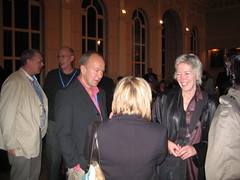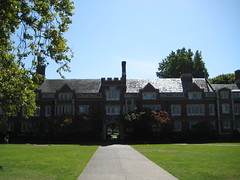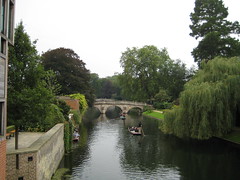“Digital Humanities and Academic Change.” Centre for Research in the Arts, Social Sciences and Humanities (CRASSH). Cambridge University. 18 September 2008.
“The New Media Encounter+.” Panel on the Blackwell Companion to Digital Literary Studies. Digital Resources in the Humanities and Arts conference (DRHA 2008). Cambridge University. 17 September 2008.
 “Peopling the Police: A Social Computing Approach to Information Authority in the Age of Web 2.0.” Digital Resources for the Humanities and Arts conference (DRHA 2008). Cambridge University. 15 September 2008. (Photos of Cambridge and DRHA)
“Peopling the Police: A Social Computing Approach to Information Authority in the Age of Web 2.0.” Digital Resources for the Humanities and Arts conference (DRHA 2008). Cambridge University. 15 September 2008. (Photos of Cambridge and DRHA)
Selected UCSB English Department Digital Initiatives
1. Department Projects
- Web Pages & Database-to-Web Sites (“Web 1.0” and “Web 1.5”)
- Blogs and Wikis (Web 2.0)
- Immersive Virtual Environments
2. UCSB English Department’s “Center” Model
Collaborative Research or Curricular Development Projects
3. Transformation Triggered by Digital Technology
- Transdisciplinarity
- Selected Courses
4. Global Humanism & Transdisciplinarity
Selected Quotations and Concepts
- Franco Moretti, Graphs, Maps, Trees: Abstract Models for a Literary History (2005):
 “But within that old territory [of literature], a new object of study: instead of concrete, individual works, a trio of artificial constructs–graphs, maps, and trees–in which the reality of the text undergoes a process of deliberate reduction and abstraction. ‘Distant reading,’ I have once call this type of approach; where distance is however not an obstacle, but a specific form of knowledge: fewer elements, hence a sharper sense of their overall interconnection. Shapes, relations, structures. Forms. Models” (p. 1).
“But within that old territory [of literature], a new object of study: instead of concrete, individual works, a trio of artificial constructs–graphs, maps, and trees–in which the reality of the text undergoes a process of deliberate reduction and abstraction. ‘Distant reading,’ I have once call this type of approach; where distance is however not an obstacle, but a specific form of knowledge: fewer elements, hence a sharper sense of their overall interconnection. Shapes, relations, structures. Forms. Models” (p. 1).
- Willard McCarty, Humanities Computing (2005):
“By ‘modelling’ I mean the heuristic process of constructing and manipulating models: a ‘model’ I take to be either a representation of something for purposes of study, or a design for realizing something new…. Two effects of computing sharpen the distinction between ‘concept’ on the one hand and the ‘model’ on the other: first, the computational demand for tractability, i.e. for complete explicitness and absolute consistency; second, the manipulability that a digital representation provides…. Take, for example, knowledge one might have of a particular concentration in a deeply familiar work of literature. In modelling one begins by privileging this knowledge, however wrong it might later turn out to be, then building a computational representation of it, e.g. by specifying a structured vocabulary of word-forms in a text-analysis tool. In the initial stages of use, this model would be almost certain to reveal trivial errors of omission and commission. Gradually, however, through perfective iteration trivial error is replaced by meaningful surprise . . . either by a success we cannot explain . . . or by a likewise inexplicable failure” (pp. 24, 25, 25-26)
- Lisa Samuels and Jerome J. McGann, “Deformance and Interpretation,” New Literary History 30, No. 1 (Winter, 1999):
“The usual object of interpretation is “meaning,” or some set of ideas that can be cast in thematic form. These meanings are sought in different ways: as though resident ‘in’ the work, or evoked through ‘reader-response,’ or deconstructable through a process that would reinstall a structure of intelligibility at a higher, more critical level…. In this paper we want to propose–or recall–another way of engaging imaginative work…. The alternative moves to break beyond conceptual analysis into the kinds of knowledge involved in performative operations–a practice of everyday imaginative life. We will argue that concept-based interpretation, reading along thematic lines, is itself best understood as a particular type of performative and rhetorical operation…. In an undated fragment on a leaf of stationery, Emily Dickinson wrote what appears to be one of her ‘letters to the world’: ‘Did you ever read one of her Poems backward, because the plunge from the front overturned you? I sometimes (often have, many times) have–a Something overtakes the Mind’ (Prose Fragment 30)…. Our deformations do not flee from the question, or the generation, of ‘meaning.’ Rather, they try to demonstrate–the way one demonstrates how to make something, or do something … that ‘meaning’ in imaginative work is a secondary phenomenon, a kind of meta-data, what Blake called a form of worship ‘Dependent’ upon some primary poetical tale. This point of view explains why, in our deformative maneuvers, interpretive lines of thought spin out of some initial nondiscursive ‘experiment’ with the primary materials. ‘Meaning’ is important not as explanation but as residue. It is what is left behind after the experiment has been run” (pp. 26, 48).
- The unstable continuum between modeling and interpreting:
- Model
- Adaptation
- Rendering
- Translation
- Simulation
- Deformance
- Edition
- Interpretation
 “Digital Humanities and Academic Change.” Reed College. 10 September 2008.
“Digital Humanities and Academic Change.” Reed College. 10 September 2008.
 “‘A Forming Hand’: Creativity and Destruction from Romanticism to Emergence Theory.” Reed College. 9 September 2008. (Photos)
“‘A Forming Hand’: Creativity and Destruction from Romanticism to Emergence Theory.” Reed College. 9 September 2008. (Photos)
Suggestions for a 21st-Century English Department
- English Departments should hire to clusters of topical or project-centered interests (e.g., literature and global media, literature and science, literature and terror) that have the potential both to foster collaboration within the department and to link up to campus-wide initiatives. Considerations of historical or field specialization should be secondary (such considerations should not be a priori, but should be generated as part of robust topics and projects).
- Every three years, each senior faculty member should be asked to teach a new course on a period, topic, or approach in which they are complete novices or are very uncomfortable.
- To foster a more genuine relation between research and teaching, one or two courses in a faculty member’s load each year should be workshop- or lab-style courses in which faculty work alongside students (grad, undergrad, or both) to produce something (e.g., an essay, a web resource, an edition, a conference, a film). At the extreme, such a course would start with no syllabus.
- Using teleconferencing or virtual-immersion information technology (e.g., Second Life instructional spaces), English departments at major research institutions in the U.S. should co-teach classes (if not whole courses) with instructors from significantly different areas of the world or different kinds of educational institutions. What do the topics and approaches that matter to “us” (e.g., identity, ethnicity, aesthetics, theory, culture, popular culture) look like when brought into dialgue with the needs and assumptions of students in Europe, Africa, or the East, students at a different grade level, adult students, students from a different social class, etc.?
- Today the assumptions that divide, and unite, “literary interpretation” and “creative writing” in a literature department should be rethought in a larger social context that privileges over both poles of that binary such goals as “innovation,” “collaboration,” and “entertainment.” In the globally competitive age of innovate-or-die and critique-by-radio-talk-show-or-blog, scholars entrenched in either interpretive critique or avant-garde creativity seem to be fighting some past war.
- English Departments should borrow paradigms from such departments as Engineering to establish robust, proactive internship programs that place students in a variety of for-profit, non-profit, and other organizations. Such an internship program should have a high level of visibility and supervision in the department–e.g., supported by an adviser who visits area businesses, arranges field trips for students, etc.
- English Departments should have a “public humanities” initiative with public events and outreach missions. Such an initiative should be coordinated alongside an extramural fund-raising campaign of the sort that other disciplines organize.
Selected UCSB English Department Digital Initiatives
1. Solo and Small-Team Projects
- Web Pages & Database-to-Web Sites (“Web 1.0” and “Web 1.5”)
- Blogs and Wikis (Web 2.0)
- Immersive Virtual Environments
2. UCSB English Department’s “Center” Model
Collaborative Research or Curricular Development Projects
3. Transformation Triggered by Digital Technology
- Transdisciplinarity
- Selected Courses
4. Global Humanism & Transdisciplinarity
Selected Quotations and Concepts
- Franco Moretti, Graphs, Maps, Trees: Abstract Models for a Literary History (2005):
 “But within that old territory [of literature], a new object of study: instead of concrete, individual works, a trio of artificial constructs–graphs, maps, and trees–in which the reality of the text undergoes a process of deliberate reduction and abstraction. ‘Distant reading,’ I have once call this type of approach; where distance is however not an obstacle, but a specific form of knowledge: fewer elements, hence a sharper sense of their overall interconnection. Shapes, relations, structures. Forms. Models” (p. 1).
“But within that old territory [of literature], a new object of study: instead of concrete, individual works, a trio of artificial constructs–graphs, maps, and trees–in which the reality of the text undergoes a process of deliberate reduction and abstraction. ‘Distant reading,’ I have once call this type of approach; where distance is however not an obstacle, but a specific form of knowledge: fewer elements, hence a sharper sense of their overall interconnection. Shapes, relations, structures. Forms. Models” (p. 1).
- Willard McCarty, Humanities Computing (2005):
“By ‘modelling’ I mean the heuristic process of constructing and manipulating models: a ‘model’ I take to be either a representation of something for purposes of study, or a design for realizing something new…. Two effects of computing sharpen the distinction between ‘concept’ on the one hand and the ‘model’ on the other: first, the computational demand for tractability, i.e. for complete explicitness and absolute consistency; second, the manipulability that a digital representation provides…. Take, for example, knowledge one might have of a particular concentration in a deeply familiar work of literature. In modelling one begins by privileging this knowledge, however wrong it might later turn out to be, then building a computational representation of it, e.g. by specifying a structured vocabulary of word-forms in a text-analysis tool. In the initial stages of use, this model would be almost certain to reveal trivial errors of omission and commission. Gradually, however, through perfective iteration trivial error is replaced by meaningful surprise . . . either by a success we cannot explain . . . or by a likewise inexplicable failure” (pp. 24, 25, 25-26)
- Lisa Samuels and Jerome J. McGann, “Deformance and Interpretation,” New Literary History 30, No. 1 (Winter, 1999):
“The usual object of interpretation is “meaning,” or some set of ideas that can be cast in thematic form. These meanings are sought in different ways: as though resident ‘in’ the work, or evoked through ‘reader-response,’ or deconstructable through a process that would reinstall a structure of intelligibility at a higher, more critical level…. In this paper we want to propose–or recall–another way of engaging imaginative work…. The alternative moves to break beyond conceptual analysis into the kinds of knowledge involved in performative operations–a practice of everyday imaginative life. We will argue that concept-based interpretation, reading along thematic lines, is itself best understood as a particular type of performative and rhetorical operation…. In an undated fragment on a leaf of stationery, Emily Dickinson wrote what appears to be one of her ‘letters to the world’: ‘Did you ever read one of her Poems backward, because the plunge from the front overturned you? I sometimes (often have, many times) have–a Something overtakes the Mind’ (Prose Fragment 30)…. Our deformations do not flee from the question, or the generation, of ‘meaning.’ Rather, they try to demonstrate–the way one demonstrates how to make something, or do something … that ‘meaning’ in imaginative work is a secondary phenomenon, a kind of meta-data, what Blake called a form of worship ‘Dependent’ upon some primary poetical tale. This point of view explains why, in our deformative maneuvers, interpretive lines of thought spin out of some initial nondiscursive ‘experiment’ with the primary materials. ‘Meaning’ is important not as explanation but as residue. It is what is left behind after the experiment has been run” (pp. 26, 48).
- The unstable continuum between modeling and interpreting:
- Model
- Adaptation
- Rendering
- Translation
- Simulation
- Deformance
- Edition
- Interpretation
 Description of talk in Cambridge University News & Events
Description of talk in Cambridge University News & Events






